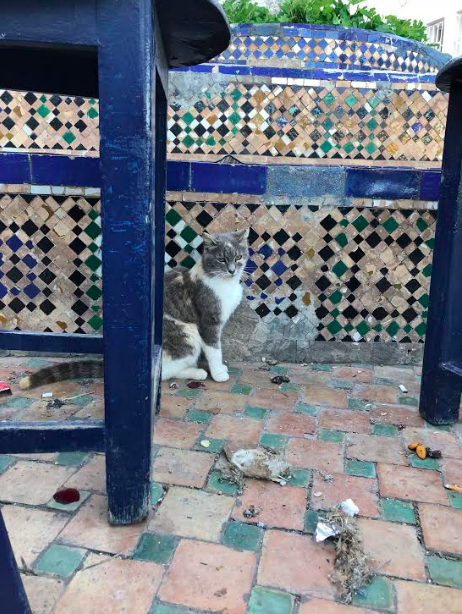Tournée des Chats: Stray Cats and the Social Life of Animals in Morocco

By Henry Robinson
[divider]
[dropcap]T[/dropcap]he cats near our hostel in Rabat congregate at night. Returning from dinner, we pass a group of them sitting serenely in the yellow light of a streetlamp, as though engaged in some silent communion. They watch us going by; I get the feeling I’ve interrupted something important. Some of them, the darker ones especially, are barely distinguishable in the shadows.
More so than many American cities, Rabat and Tangier are full of stray cats – lounging in doorways, begging for scraps at sidewalk cafés, weaving between the legs of shoppers in crowded medina streets. They are stunningly bold; many of them have no qualms about getting close to strangers, accepting ear scratches and coos from the people they meet. Certain parts of Rabat, such as the Oudayas Kasbah Gardens, have practically become cat sanctuaries, full of kittens and larger cats who come for the free water (left out for them in plastic bowls) and the affection of locals.
At one of these impromptu feline hubs – the Roman/Islamic/Greek ruins of Chellah outside Rabat – I meet a small white-and-brown kitten who (on a whim) I name Vespasian, after the Roman emperor who ruled from AD 69-79. He’s immediately friendly, even more so than many of the other cats; he jumps on my lap and starts purring almost as soon as I sit down on a stone, and he’s an affection sponge, who can’t get enough of my ear scratches. But after I get up, he drifts away and starts exploring on his own, only following me briefly.
Most of the cats turn out to be that way, regardless of how affectionate they are in the moment you encounter them. They’re not cruel or unkind by any means; they just have their own lives, and they don’t expect too much from strangers. Vespasian only leaves me, after all, because I get up and leave him. More people will come to the ruins eventually (they’re a popular tourist site) and he’ll find someone else.
Stray cats have their own social networks, an animal society parallel to the human one in whose edifices they live. It’s easy to forget this in American cities, where stray animals of any kind are less visible, relegated to alleys and the dark corners of public parks. But in Morocco, human and animal brush up against each other constantly, in tentative, brief encounters. Sometimes I wonder if we’re as inscrutable to the cats as they are to us; if the group of cats near our hostel looks at us, going by in a group of our own, and wonders about our language; the signs, gestures, cues by which we interact; our norms and codes. It’s more likely that they don’t care, but it’s nice to imagine that they’re curious – taking mental notes on our habits and trying to understand the bevy of sounds we speak at each other.
It’s remarkable how open and peaceful this human/animal coexistence is; although most health advisors will caution against approaching stray animals in foreign countries, many of the locals have no problem touching the cats that wander around their streets. Even though I pet enough cats to make a doctor terrified, they never make me sick; and apart from a few store owners shooing cats away, I see very little human hostility toward the cities’ feline populations. They’ve arrived at a kind of understanding, these parallel societies, even if they don’t understand each other very well.
As I finish writing this, I’m sitting in my living room with my three cats, who socialize with each other in ways I can only grasp through basic ideas – play, confrontation, affection. But if my time in Morocco has taught me anything about animal life, it’s that there’s a lot about it that I can’t fully grasp – that I might only be able, like the group of cats outside our hostel, to sit back and watch and try, feebly, to understand.
[hr]
Henry is a rising senior in Silliman. You can contact him at henry.robinson@yale.edu.